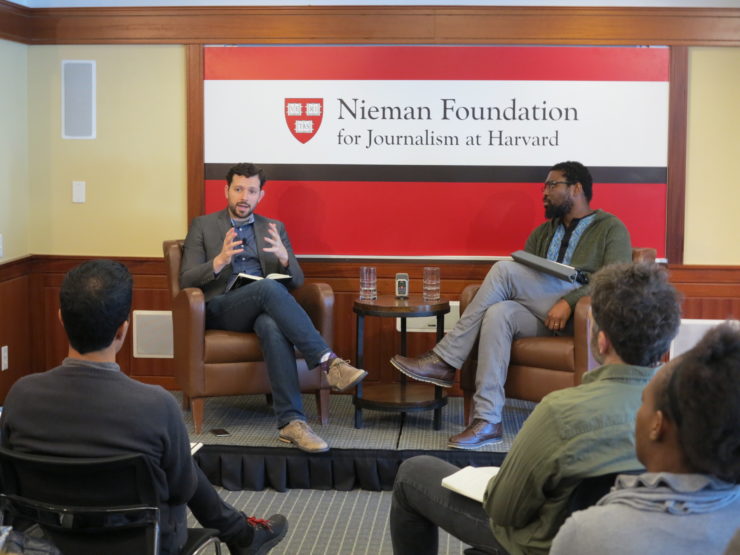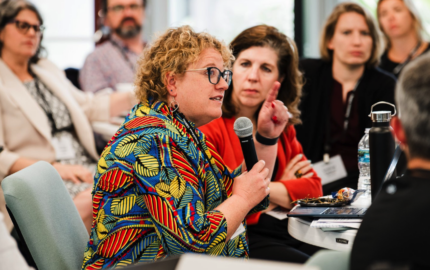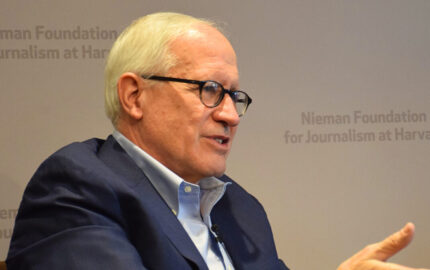Twitter has been enjoying more than a moment recently, most notably whenever President Trump tweets. Yet, 11 years after its founding and at a time when tweets are must-reads and a tool for journalists on beats from Hollywood to D.C., the company is struggling to satisfy investors.
During a recent talk at the Nieman Foundation, Andrew Fitzgerald, Twitter's director of curation, discussed the value of looking at news through a conversational lens. He joined the company in 2011 after stints at the now-defunct Current TV, the user-generated content channel co-owned by Al Gore, and “The Stream,” Al Jazeera’s television show that examines social media’s role in disseminating news.
Today Fitzgerald (@magicandrew) oversees the global teams responsible for Twitter Moments. They identify the best conversations, live reporting, memes, and commentary happening across the social media platform. Edited excerpts:
I think there are three levels of Twitter as a newsgathering tool. The first is what's happening in your home timeline, just following the accounts that are sharing the information that is important to whatever you're covering. Particularly, if you’re a beat reporter, you can go deep into publications in your beat. You can go deep into associated individuals, like the CEO. If you’re an aviation reporter, you can start following individual engineers who happen to talk a bit about their job in the public space. That’s a timeline. It’s highly focused, defined over time.
The second level is TweetDeck, plugging in keywords and filtering them down by location, by the content that is included in the tweet, whether it includes a photo or a video.
The third is a project I worked on at Twitter with a company called Dataminr. A fair number of news organizations around the world have contracts with Dataminr. It's a third‑party system that algorithmically detects potentially breaking news on Twitter. Dataminr was begun as a tool for finance, because if you are a hedge fund trader and you can know faster than anyone else who’s trading oil that there was a massive explosion in Port Harcourt, you can make a lot of money on that. We worked with them to offer the same technology to newsrooms. It's something we still use every day on Twitter Moments.
If you’re new to Twitter or are a casual user, go on a following spree, finding all of the individuals in and around the topics that you cover. They will surprise you. As you get deeper and deeper into the individuals around the topics that you cover, you may find things. Engage, be a part of conversations, have conversations with people. Put your work out there, let people respond to it, have conversations with people who respond to it, respond to other people’s work.
The idea of looking at news through a conversational lens is powerful and can be applied to any news entity. The way people are talking about something in the world is in itself news. It’s something we’re seeing, certainly in the political news cycle in the United States. Increasingly, the conversation itself is driving that news cycle. Twitter is still the platform of choice for President Donald Trump. To have such a level of insight into the day‑to‑day thoughts of the president is certainly unprecedented.
As you think about what makes the curation of content from platforms powerful, first it’s the selection, “Are you picking the right stuff?” but then, it’s the context. To be able to identify, “Here’s a tweet from the president. Here’s the reaction that it generated. Here are individuals who are disagreeing. Here are other individuals who are supporting, who are providing additional context that the president neglected to include in the original tweet.” To be able to pull that together into a full story is a very powerful and necessary format if Twitter is the president’s medium of choice.
I think that there is something very powerful in not separating the news from the memes that the news generates. As you look at the way younger audiences consume news, keeping that in the same story is really important. An integral part of the story of “The White House may add a 20 percent tariff on imports from Mexico” is “What is the reaction?” and part of the reaction is funny. One response was “Trump's proposed import tax sparks widespread guacamole panic,” paired with one of the best avocado GIFs I’ve seen. Then you start to get into the memes and the funny reactions like “GUAC AT CHIPOTLE IS ALREADY TWO DOLLARS BASICALLY NOW TRUMP IS GONNA TAX MEXICAN IMPORTS AND YOU SAID THIS GUY WAS A POPULIST?” We shouldn’t be afraid to include the funny parts with the serious. Younger audiences don't expect clear lines between “this is important news” and “this is funny.”
Building out your profile as a journalist is important for two reasons. One is having a public‑facing profile on Twitter allows you to be a distribution channel for the work that you're doing. On Twitter people often prefer to follow individuals as opposed to organizations. People have coalesced in the news space around individual journalists as opposed to the brands. The news brands several years ago did a good job of pushing people away from them by setting up auto tweeting RSS feeds, whereas individual reporters were pulling out the best surprising quote from a story and using that to promote the story.
The second reason to build your profile is that using Twitter as a newsgathering tool often means that you are reaching out to individuals on Twitter and trying to establish trust with them, either as a source or as an eyewitness. Having that public face gives you a bit more credibility in those conversations.
We had a deep conversation inside of the company about “Do we feel like it is our role to correct a falsehood?” The path that we chose is, “Yes, we should very clearly state if the president tweets wrongly that three to five million voted illegally.”
The additional step that we take is we showed our work. We showed multiple sources to show that it was a consensus in the media that this was, in fact, false.
I do not advocate for Twitter as a replacement for the press conference. It is, perhaps, like the press release. There are some politicians who use it entirely as a distribution mechanism. Some politicians use Twitter very much as a two‑way communication channel. The legislators in Washington will say something, people will respond to it, and they will engage with their constituents.
We think about Moments as a way to amplify great journalism. Our mantra for Moments is, “From the scene or from the source.” We're looking for those tweets that are directly from the scene where news is breaking or directly from a source who’s involved. What that leaves out is context. Whether it is the photo from the center of the protest or the tweet from the celebrity announcing XYZ in his or her career, we will need to contextualize it, and we rely very heavily on tweets from the news community to do that.
For anyone on Twitter, there is the opportunity to break your own bubble, just late‑night with a glass of wine, digging through a bunch of weird accounts you've never seen before. What you might call Media Twitter is absolutely a thriving bubble of mutual follows. What we’re trying to do with Moments and with Explore is, “Here is other things that are happening. Here are other takes on these conversations.”
Because we have the advantage of having a curation team, there are things that we can do to debunk things in a public way. We can say next to your timeline, “Hey, by the way, this celebrity’s name is trending,” and if there happens to be a false death rumor, we can just write right there, “This person is still alive.” That kind of nudge influence can help reduce the spread of these things.
For individual journalists, I think it’s a big challenge. Unfortunately, the meme‑fication of what feels like news is emotionally more powerful than the fact‑check. I don’t know the solution. We’re working closely with First Draft News, as are some other companies, trying to figure this stuff out. It could be that the platforms build ways to flag this stuff. It could be that in addition to that or in parallel, journalists begin to build techniques to tell stories in that same strange language that is so emotionally resonant, that can compete head‑to‑head with those things. That seems like a very hard path, but maybe worth some experimentation.
During a recent talk at the Nieman Foundation, Andrew Fitzgerald, Twitter's director of curation, discussed the value of looking at news through a conversational lens. He joined the company in 2011 after stints at the now-defunct Current TV, the user-generated content channel co-owned by Al Gore, and “The Stream,” Al Jazeera’s television show that examines social media’s role in disseminating news.
Today Fitzgerald (@magicandrew) oversees the global teams responsible for Twitter Moments. They identify the best conversations, live reporting, memes, and commentary happening across the social media platform. Edited excerpts:
On Twitter as a newsgathering tool
I think there are three levels of Twitter as a newsgathering tool. The first is what's happening in your home timeline, just following the accounts that are sharing the information that is important to whatever you're covering. Particularly, if you’re a beat reporter, you can go deep into publications in your beat. You can go deep into associated individuals, like the CEO. If you’re an aviation reporter, you can start following individual engineers who happen to talk a bit about their job in the public space. That’s a timeline. It’s highly focused, defined over time.
The second level is TweetDeck, plugging in keywords and filtering them down by location, by the content that is included in the tweet, whether it includes a photo or a video.
The third is a project I worked on at Twitter with a company called Dataminr. A fair number of news organizations around the world have contracts with Dataminr. It's a third‑party system that algorithmically detects potentially breaking news on Twitter. Dataminr was begun as a tool for finance, because if you are a hedge fund trader and you can know faster than anyone else who’s trading oil that there was a massive explosion in Port Harcourt, you can make a lot of money on that. We worked with them to offer the same technology to newsrooms. It's something we still use every day on Twitter Moments.
If you’re new to Twitter or are a casual user, go on a following spree, finding all of the individuals in and around the topics that you cover. They will surprise you. As you get deeper and deeper into the individuals around the topics that you cover, you may find things. Engage, be a part of conversations, have conversations with people. Put your work out there, let people respond to it, have conversations with people who respond to it, respond to other people’s work.
On news through a conversational lens
The idea of looking at news through a conversational lens is powerful and can be applied to any news entity. The way people are talking about something in the world is in itself news. It’s something we’re seeing, certainly in the political news cycle in the United States. Increasingly, the conversation itself is driving that news cycle. Twitter is still the platform of choice for President Donald Trump. To have such a level of insight into the day‑to‑day thoughts of the president is certainly unprecedented.
As you think about what makes the curation of content from platforms powerful, first it’s the selection, “Are you picking the right stuff?” but then, it’s the context. To be able to identify, “Here’s a tweet from the president. Here’s the reaction that it generated. Here are individuals who are disagreeing. Here are other individuals who are supporting, who are providing additional context that the president neglected to include in the original tweet.” To be able to pull that together into a full story is a very powerful and necessary format if Twitter is the president’s medium of choice.
On the value of memes
I think that there is something very powerful in not separating the news from the memes that the news generates. As you look at the way younger audiences consume news, keeping that in the same story is really important. An integral part of the story of “The White House may add a 20 percent tariff on imports from Mexico” is “What is the reaction?” and part of the reaction is funny. One response was “Trump's proposed import tax sparks widespread guacamole panic,” paired with one of the best avocado GIFs I’ve seen. Then you start to get into the memes and the funny reactions like “GUAC AT CHIPOTLE IS ALREADY TWO DOLLARS BASICALLY NOW TRUMP IS GONNA TAX MEXICAN IMPORTS AND YOU SAID THIS GUY WAS A POPULIST?” We shouldn’t be afraid to include the funny parts with the serious. Younger audiences don't expect clear lines between “this is important news” and “this is funny.”
On building your profile
Building out your profile as a journalist is important for two reasons. One is having a public‑facing profile on Twitter allows you to be a distribution channel for the work that you're doing. On Twitter people often prefer to follow individuals as opposed to organizations. People have coalesced in the news space around individual journalists as opposed to the brands. The news brands several years ago did a good job of pushing people away from them by setting up auto tweeting RSS feeds, whereas individual reporters were pulling out the best surprising quote from a story and using that to promote the story.
The second reason to build your profile is that using Twitter as a newsgathering tool often means that you are reaching out to individuals on Twitter and trying to establish trust with them, either as a source or as an eyewitness. Having that public face gives you a bit more credibility in those conversations.
On calling out lies
We had a deep conversation inside of the company about “Do we feel like it is our role to correct a falsehood?” The path that we chose is, “Yes, we should very clearly state if the president tweets wrongly that three to five million voted illegally.”
The additional step that we take is we showed our work. We showed multiple sources to show that it was a consensus in the media that this was, in fact, false.
On Twitter as two-way communication
I do not advocate for Twitter as a replacement for the press conference. It is, perhaps, like the press release. There are some politicians who use it entirely as a distribution mechanism. Some politicians use Twitter very much as a two‑way communication channel. The legislators in Washington will say something, people will respond to it, and they will engage with their constituents.
On access to the scene or source
We think about Moments as a way to amplify great journalism. Our mantra for Moments is, “From the scene or from the source.” We're looking for those tweets that are directly from the scene where news is breaking or directly from a source who’s involved. What that leaves out is context. Whether it is the photo from the center of the protest or the tweet from the celebrity announcing XYZ in his or her career, we will need to contextualize it, and we rely very heavily on tweets from the news community to do that.
On breaking out of one’s bubble
For anyone on Twitter, there is the opportunity to break your own bubble, just late‑night with a glass of wine, digging through a bunch of weird accounts you've never seen before. What you might call Media Twitter is absolutely a thriving bubble of mutual follows. What we’re trying to do with Moments and with Explore is, “Here is other things that are happening. Here are other takes on these conversations.”
On fake news
Because we have the advantage of having a curation team, there are things that we can do to debunk things in a public way. We can say next to your timeline, “Hey, by the way, this celebrity’s name is trending,” and if there happens to be a false death rumor, we can just write right there, “This person is still alive.” That kind of nudge influence can help reduce the spread of these things.
For individual journalists, I think it’s a big challenge. Unfortunately, the meme‑fication of what feels like news is emotionally more powerful than the fact‑check. I don’t know the solution. We’re working closely with First Draft News, as are some other companies, trying to figure this stuff out. It could be that the platforms build ways to flag this stuff. It could be that in addition to that or in parallel, journalists begin to build techniques to tell stories in that same strange language that is so emotionally resonant, that can compete head‑to‑head with those things. That seems like a very hard path, but maybe worth some experimentation.



